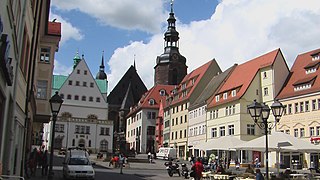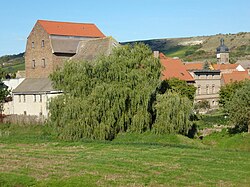
Saxony-Anhalt is a state of Germany, bordering the states of Brandenburg, Saxony, Thuringia and Lower Saxony. It covers an area of 20,451.7 square kilometres (7,896.4 sq mi) and has a population of 2.17 million inhabitants, making it the 8th-largest state in Germany by area and the 11th-largest by population. Its capital is Magdeburg and its largest city is Halle (Saale).
The Kyffhäuserkreis is a district in the northern part of Thuringia, Germany. Neighboring districts are the districts Mansfeld-Südharz, Saalekreis und Burgenlandkreis in Saxony-Anhalt, and the districts Sömmerda, Unstrut-Hainich-Kreis and Eichsfeld.

The Province of Saxony, also known as Prussian Saxony was a province of the Kingdom of Prussia and later the Free State of Prussia from 1816 until 1944. Its capital was Magdeburg.

Nebra (official name: Nebra (Unstrut), pronounced [ˈneːbra ˈʊnʃtʁuːt]) is a town in the district of Burgenlandkreis of Saxony-Anhalt, Germany. It is situated on the river Unstrut. Nebra has become nationally and internationally known as the site where the Nebra sky disc, a notable Bronze Age artifact, was discovered. The town has a population of around 3,300.

The Únětice culture, Aunjetitz culture or Unetician culture is an archaeological culture at the start of the Central European Bronze Age, dated roughly to about 2300–1600 BC. The eponymous site for this culture, the village of Únětice, is located in the central Czech Republic, northwest of Prague. There are about 1,400 documented Únětice culture sites in the Czech Republic and Slovakia, 550 sites in Poland, and, in Germany, about 500 sites and loose finds locations. The Únětice culture is also known from north-eastern Austria, and from western Ukraine.

Eisleben is a town in Saxony-Anhalt, Germany. It is famous as both the hometown of the influential theologian Martin Luther and the place where he died; hence, its official name is Lutherstadt Eisleben. First mentioned in the late 10th century, Eisleben is divided into old and new towns, the latter of which was created for Eisleben's miners in the 14th century. As of 2020, Eisleben had a population of 22,668. It lies on the Halle–Kassel railway.

Querfurt is a town in the Saalekreis district, or Kreis, in southern Saxony-Anhalt, Germany. It is located in a fertile area on the Querne, 18 miles (29 km) west from Merseburg. In 2020, the town had a population of 10,454. The town Querfurt consists of Querfurt proper and the following 8 Ortschaften or municipal divisions: Gatterstädt, Grockstädt, Leimbach, Lodersleben, Schmon, Vitzenburg, Weißenschirmbach and Ziegelroda.

Mansfeld, sometimes also unofficially Mansfeld-Lutherstadt, is a town in the district of Mansfeld-Südharz, in Saxony-Anhalt, Germany.

Schraplau is a town in the Verbandsgemeinde Weida-Land, part of the district of Saalekreis, in the State of Sachsen-Anhalt, Germany. It is situated approximately 8 km (5 mi) northeast of Querfurt. It is also considered part of the Halle-Leipzig metropolitan area.
Burgenlandkreis is a district in Saxony-Anhalt, Germany. Its area is 1,414.0 km2 (545.9 sq mi).

Balgstädt is a municipality in the Burgenlandkreis district, in Saxony-Anhalt, Germany. Since 2009 it has incorporated the former municipalities of Burkersroda, Größnitz and Hirschroda.
Röblingen am See is a village and a former municipality in the Mansfeld-Südharz district, Saxony-Anhalt, Germany. Since 1 January 2010, it is part of the municipality Seegebiet Mansfelder Land, of which it is the administrative centre.

Brücken-Hackpfüffel is a municipality in the Mansfeld-Südharz district, Saxony-Anhalt, Germany. It was formed on 1 January 2009 by the merger of the former municipalities Brücken and Hackpfüffel.

The Helme is river in central Germany that is about 65 kilometres (40 mi) long and which forms a left-hand, western tributary of the Unstrut in the states of Thuringia and Saxony-Anhalt.

The Hassegau was a medieval shire (Gau) in the Eastphalia region of the Duchy of Saxony. It was located in the duchy's southeastern corner; confined by the Saale river to the east and its Unstrut and Wipper tributaries to the south and north. Its most important town was Merseburg. In present-day borders, it is in the southeastern part of Saxony-Anhalt.

The Karsdorf remains are the bodies of more than 30 Neolithic humans who were buried in the vicinity of Karsdorf, Sachsen-Anhalt, Germany.

Pettstädt, formally an independent official village in the Duchy of Saxony, is presently a portion of the city of Weißenfels in the Burgenlandkreis of Sachsen-Anhalt.

The Mitteldeutscher Verkehrsverbund (MDV) is a transport association in the German Leipzig-Halle (Saale) area. The company is based in Halle (Saale), but its head office is in Leipzig.
The Volkswagen Zwickau-Mosel Plant is an automobile factory, which was founded on 26 September 1990 in today's Zwickau district of Mosel and together with the Chemnitz plant and the Transparent Factory belongs to Volkswagen Sachsen based in Zwickau. Currently, the Zwickau plant has about 8,000 employees. Signalling a milestone the last combustion vehicle was produced on 26 June 2020.






















